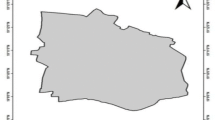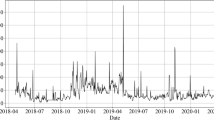Abstract
In the present study, a stationary stochastic ARMA/ARIMA [Autoregressive Moving (Integrated) Average] modelling approach has been adapted to forecast daily mean ambient air pollutants (O3, CO, NO and NO2) concentration at an urban traffic site (ITO) of Delhi, India. Suitable variance stabilizing transformation has been applied to each time series in order to make them covariance stationary in a consistent way. A combination of different information-criterions, namely, AIC (Akaike Information Criterion), HIC (Hannon–Quinn Information Criterion), BIC (Bayesian Information criterion), and FPE (Final Prediction Error) in addition to ACF (autocorrelation function) and PACF (partial autocorrelation function) inspection, has been tried out to obtain suitable orders of autoregressive (p) and moving average (q) parameters for the ARMA(p,q)/ARIMA(p,d,q) models. Forecasting performance of the selected ARMA(p,q)/ARIMA(p,d,q) models has been evaluated on the basis of MAPE (mean absolute percentage error), MAE (mean absolute error) and RMSE (root mean square error) indicators. For 20 out of sample forecasts, one step (i.e., one day) ahead MAPE for CO, NO2, NO and O3, have been found to be 13.6, 12.1, 21.8 and 24.1%, respectively. Given the stochastic nature of air pollutants data and in the light of earlier reported studies regarding air pollutants forecasts, the forecasting performance of the present approach is satisfactory and the suggested forecasting procedure can be effectively utilized for short term air quality forewarning purposes.











Similar content being viewed by others
References
Akaike H (1974) A new look at the statistical model identification. IEEE Trans Autom Control 19:716–723
Argiriou AA (2007) Use of neural networks for tropospheric ozone time series approximation and forecasting––a review. Atmos Chem Phys Discuss 7:5739–5767
Athanasiadis IN, Karatzas K, Mitkas P (2005) Contemporary air quality forecasting methods: a comparative analysis between classification algorithms and statistical methods. In: Sokhi R, Brexhler J (eds) Fifth international conference on urban air quality measurement, modelling and management, Valencia, Spain, March 2005
Box GEP, Jenkins GM, Reinsel GC (1994) Time series analysis. Forecasting and control, 3rd edn. Prentice-Hall, Inc., Englewood Cliffs, NJ
Brockwell JB, Davis RA (2002) Introduction to time series and forecasting. Springer, New York
Cai M, Yin Y, Xie M (2009) Prediction of hourly air pollutant concentrations near urban arterials using artificial neural network approach. Transp Res D Trans Environ 14:32–41
Chelani AB, Devotta S (2006) Air quality forecasting using a hybrid autoregressive and nonlinear model. Atmos Environ 40:1774–1780
Hannan EJ, Quinn BG (1979) The determination of the order of an autoregression. J R Stat Soc B 41:190–195
IMD (2009) http://www.imd.gov.in/. Accessed June 2009
Kim SE (2008) Tree-based threshold modeling for short-term forecast of daily maximum ozone level. Stochastic Environmental Research and Risk Assessment. doi:10.1007/s00477-008-0295-6
Kim SE, Kumar A (2005) Accounting seasonal nonstationarity in time series models for short-term ozone level forecast. Stoch Environ Res Risk Assess 19:241–248
Kumar K, Yadav AK, Singh MP, Hassan H, Jain VK (2004) Forecasting daily maximum surface ozone concentrations in Brunei Darussalam––an ARIMA modelling approach. J Air Waste Manag Assoc 84:809–814
Ljung L (1999) System identification––theory for the user. Prentice Hall PTR, NJ
Ljung L (2002) System identification toolbox––for use with MATLAB®, Version 5. The Mathworks, Inc., 3 Apple Hill Drive, Natick, MA, USA
Lurmann FW, Kumar N, Londergan R, Moore G (2007) Evaluation of the UAM-V model performance in the northeast region for OTAG Episodes. Prepared for submission to: ozone transport assessment group (OTAG) 1997. Air quality analysis workgroup, USEPA. http://capita.wustl.edu/OTAG/Reports/Sonoma/Report2.1.html#tabletwoone. Accessed Jan 2008
Nelson CR (1976) The interpretation of R2 in autoregressive-moving average time series models. Am Stat 30:175–180
Robeson SM, Steyn DG (1990) Evaluation and comparison of statistical forecast models for daily maximum ozone concentrations. Atmos Environ 24B:303–312
Schmidt AB (2005) Quantitative finance for physicists. Elsevier Academic Press, pp 7–8
Schwarz G (1978) Estimating the dimension of a model. Annal Stat 6:461–464
Seinfeld JH, Pandis SN (2006) Atmospheric chemistry and physics: from air pollution to climate change. John Wiley & Sons, NJ, US
Shibata R (1976) Selection of the order of an autoregressive model by Akaike’s information criterion. Biometrika 63:117–126
Shumway RH, Stoffer DS (2006) Time series analysis and its applications––with R examples. Springer Science + Business Media, LLC
Thompson ML, Reynolds J, Cox LH, Guttorp P, Sampson PD (2001) A review of statistical methods for the meteorological adjustment of tropospheric ozone. Atmos Environ 35:617–630
Author information
Authors and Affiliations
Corresponding author
Rights and permissions
About this article
Cite this article
Kumar, U., Jain, V.K. ARIMA forecasting of ambient air pollutants (O3, NO, NO2 and CO). Stoch Environ Res Risk Assess 24, 751–760 (2010). https://doi.org/10.1007/s00477-009-0361-8
Published:
Issue Date:
DOI: https://doi.org/10.1007/s00477-009-0361-8




